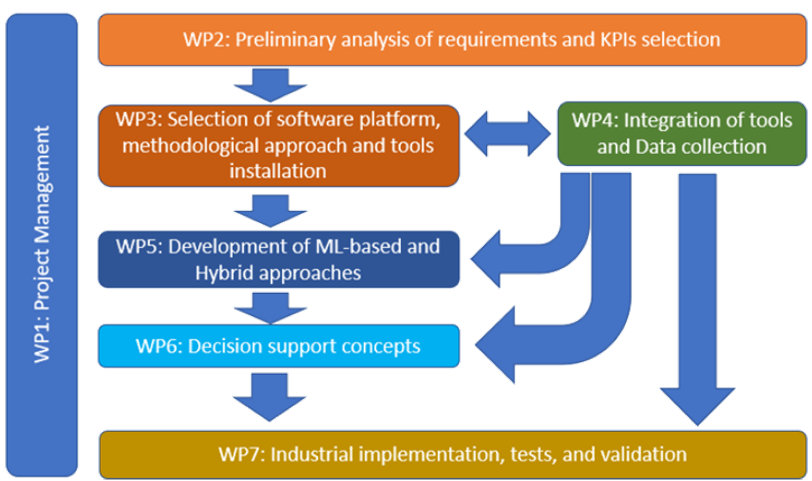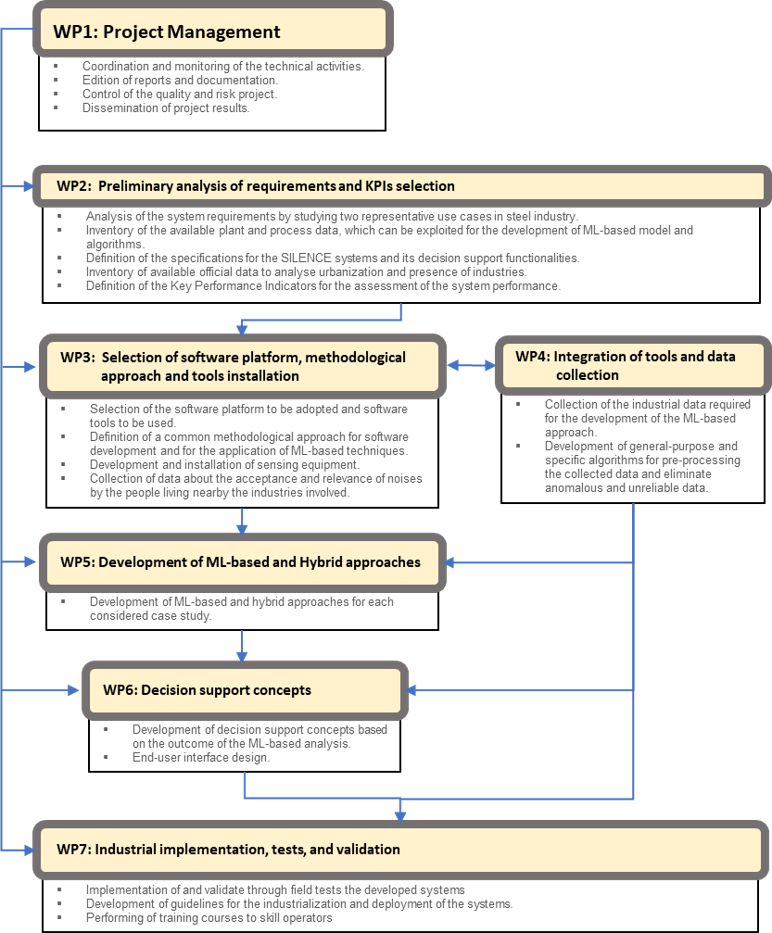The SILENT consortium is coordinated by CSM following the guidelines of the RFCS program and it has defined a clear-cut assignment of responsibilities and tasks to be performed by the partners. The project is divided into 7 complementary and interrelated work packages (WPs) as illustrated below:

WP1 - Project Coordination and Management
Objective:
Ensure effective coordination, quality control, risk management, and
dissemination.
- Coordinate project meetings and monitor progress.
- Prepare reports and deliverables with input from all partners.
- Manage risks and ensure quality standards.
- Disseminate results across the European and international steel sector, respecting confidentiality and IPR.
Activities and results:
During the 'Digital-4-Environment' workshop (Feb. 2024), a poster was presented
WP2 - System Requirements and Data Inventory
Objective:
Define system requirements and data sources through industrial use cases
and social analysis.
- Defined system requirements for the plants of both the industrial partners.
- Identified the most relevant process data, secured access to meteorological data (through on-site stations and web sites) and gathered Historical and current acoustic data from communities near the plants.
- Defined Key Performance Indicators (KPIs) to evaluate system performance and noise reduction effectiveness.
- Collected stakeholder feedback through interviews and questionnaires with workers, management, and local residents.
WP3 - Platform Design and Sensor Deployment
Objective:
Define the software platform, development methodology, and deploy
acoustic monitoring systems.
- Defined the methodological framework for data acquisition, management, and software development with ML integration for a Decision Support System.
- Selected software platforms, programming tools, and databases compatible with industrial IT for algorithm development and ML/statistical analysis.
- Industrial partners and consortium chose the type and location of sound level sensors for required measurements.
- Analysis of complaints and official data revealed significant noise issues near APERAM, with direct questionnaires as the most reliable source.
WP4 - Data Collection and Pre-processing
Objective:
Collect industrial and acoustic data and develop pre-processing
algorithms for ML applications.
- Hypothesized a possible acoustic signal and development of the calculations to identify the threshold for impulsive phenomena and a neural models that will be used to predict noise levels
- The collection of weather and acoustic data has started (FENO case)
WP5 - Development of ML-Based Models
Objective:
Develop machine learning and hybrid models tailored to each industrial
case study.
- The development of ML and hybrid models for noise prediction is delayed due to insufficient data from industrial servers.
WP6 - Decision Support System and User Interface
Objective:
Develop decision support tools and design an intuitive user interface.
- The two industrial partners have defined the first version of their DSSs with a first draft of the activities and countermeasures to be adopted in case of exceeding the tolerable thresholds.
WP7 - System Validation, Guidelines and Training
Objective:
Test the SILENCE system in real industrial settings, assess results, and
support future deployment.
- Implement and validate the DSS at FENO and APERAM through field tests and operator feedback.
- Compare pre- and post-implementation acoustic data to evaluate system effectiveness.
- Develop industrialization guidelines and assess economic feasibility.
- Organize training modules for operators and evaluate social impact through surveys.

